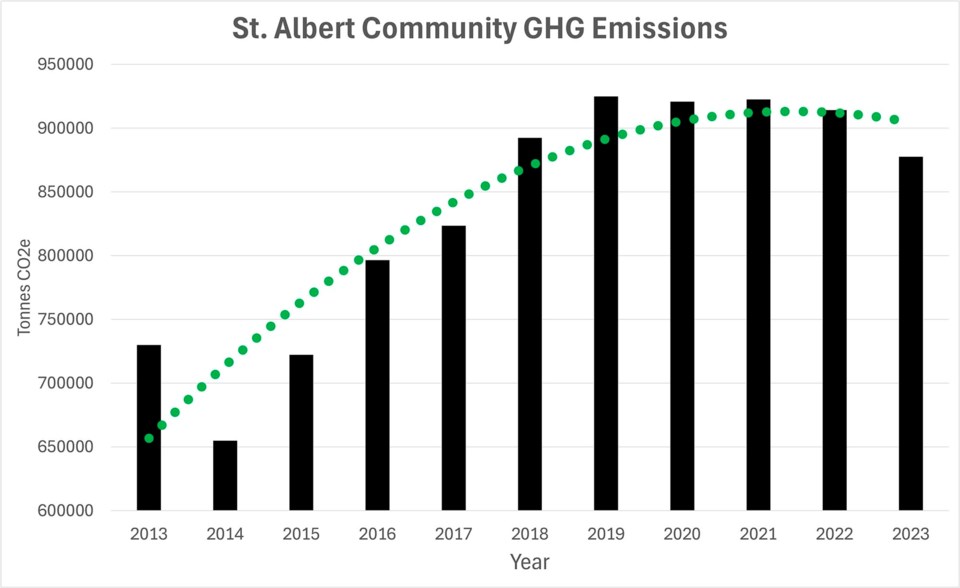St. Albert’s greenhouse gas emissions may have peaked after nearly a decade of constant growth, the city’s final report on the environment suggests.
The City of St. Albert released the 2023 Report on the Environment in December. The report tracks the city’s progress towards goals set in its Environmental Master Plan.
The report was supposed to be released around Earth Day in April, but was delayed until now because of manpower issues, city environment manager Meghan Myers said in an interview.
“This is going to be our last report on the Environmental Master Plan,” Myers noted, as that document has been supplanted by the 2024 Green Environment Strategy.
That strategy does not currently have any specific numerical targets, but features aspirational goals such as protecting natural features and enhancing biodiversity. It also tracks measures such as tree cover, density, and loss of natural areas, and sets out a schedule for actions to meet its goals.
Myers said her office is still working on baseline data for the strategy and wasn’t sure if the city would set numerical targets for it. The one exception was for climate change, as provincial and federal grants require the city to have a greenhouse gas reduction target.
Climate progress
St. Albert as a community reduced its emissions of heat-trapping pollution to about two per cent below 2008 levels in 2023 — a far cry from its goal of six per cent. Still, this was the second year in a row the city’s total emissions went down, and the first time they dipped below the all-time high set in 2019.
Myers agreed this suggests St. Albert’s greenhouse gas emissions may have reached a peak for the first time.
“We’re not increasing anymore, which is a positive.”
Myers said this drop could be the result of more efficient homes, vehicles, and technologies reaching the market, federal incentive programs, and the Clean Energy Improvement Program (CEIP) and Home Energy Efficiency Grant (HEEG), both of which launched in late 2022.
Some 189 homeowners got grants for home insulation, air-sealing, and other energy-saving measures under HEEG in 2023, while 34 homeowners got low-interest loans to fund green retrofits through CEIP, the report showed.
The city’s corporate emissions were now 29.6 per cent below 2008 levels — 10 per cent lower than in 2022 and far below the city’s target of 20 per cent below by 2020. This marked the fourth year in a row the city has surpassed its emissions reduction target.
Myers said the city has been helped here by a large number of federal and provincial grants, its dedicated energy efficiency officer, and major energy retrofits to Servus Place and Fountain Park Pool. She predicts further reductions in 2025 as the crews continue work on the retrofit of St. Albert Place and add more energy-saving REALIce devices to city arenas.
Trash and water
St. Albert’s waste diversion rate edged up to 51 per cent in 2023 — better than the 46 per cent of 2022 but still behind the 62 per cent reached in 2019.
The introduction of Extended Producer Responsibility in Alberta next April 1 should help St. Albert keep more trash out of the dump, said John Potter, the city’s manager of transportation operations and waste management. This new provincial policy will make producers responsible for recycling instead municipalities, resulting in lower utility bills and more items accepted for recycling.
“We’re going to see more material accepted in blue bag curbside pickup. We just don’t know what those materials are as of right now.”
Water consumption edged up to 218 L/person/day in 2023 from 215 the year before, the report showed, likely because of a hot, dry summer. In addition to its rain barrel program, Myers said the city would focus on behavioural change through education next year to try and drive down water use.
The 2023 Report on the Environment can be found at stalbert.ca/city/environment/reports/report-on-the-environment.




